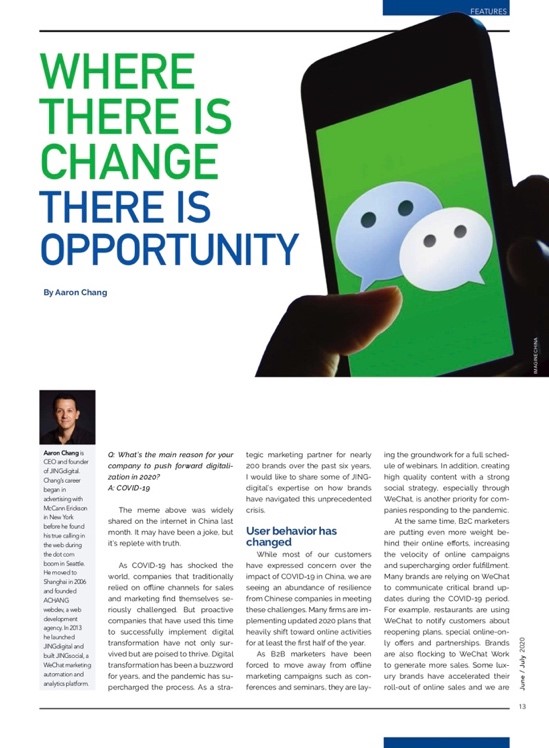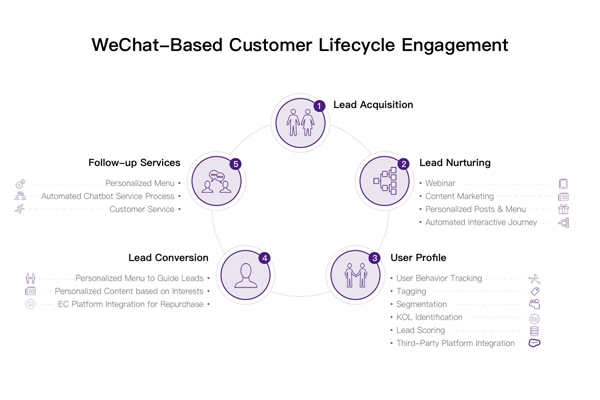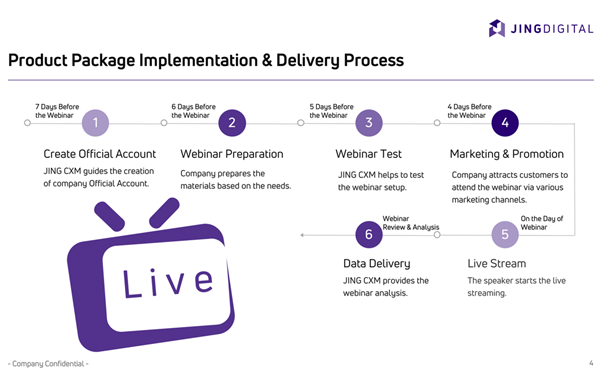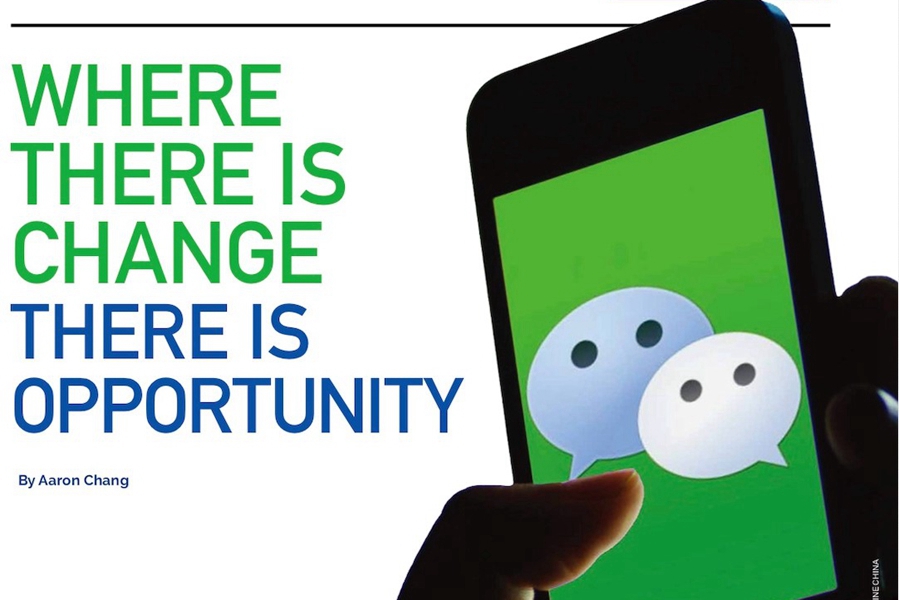Q: What’s the main reason for you company to push forward digitalization in 2020?
A: COVID-19
The meme above was widely shared on the internet in China last month. It may have been a joke, but it’s replete with truth.

As COVID-19 has shocked the world, companies that traditionally relied on offline channels for sales and marketing find themselves seriously challenged. But proactive companies that have used this time to successfully implement digital transformation have not only survived but are poised to thrive. Digital transformation has been a buzzword for years, and the pandemic has supercharged the process. As a strategic marketing partner for nearly 200 brands over the past six years, I would like to share some of JINGdigital’s expertise on how brands have navigated this unprecedented crisis.
Part 1:User Behavior Has Changed
While most of our customers have expressed concern over the impact of COVID-19 in China, we are seeing an abundance of resilience from Chinese companies in meeting these challenges. Many firms are implementing updated 2020 plans that heavily shift toward online activities for at least the first half of the year.
As B2B marketers have been forced to move away from offline marketing campaigns such as conferences and seminars, they are laying the groundwork for a full schedule of webinars. In addition, creating high quality content with a strong social strategy, especially through WeChat, is another priority for companies responding to the pandemic.
At the same time, B2C marketers are putting even more weight behind their online efforts, increasing the velocity of online campaigns and supercharging order fulfillment. Many brands are relying on WeChat to communicate critical brand updates during the COVID-19 period. For example, restaurants are using WeChat to notify customers about reopening plans, special online-only offers and partnerships. Brands are also flocking to WeChat Work to generate more sales. Some luxury brands have accelerated their roll-out of online sales and we are seeing brands accelerate the digitalization of the sales process.
One of our clients, a European luxury retailer with over 50 stores in China, has accelerated digitalization for their 300+ sales associates. The associates are now equipped with the JINGsales Wechat Work-based social selling tool. As a result, over 40,000 of their customers are now connected directly with the brand digitally. The click through rate for product recommendation content averages 95%, while the purchase conversion rate is 17%.
Part 2: The New Working Normal
We believe the recent increased focus on digitalization is neither a fad nor a transient buzzword, but a long-term shift that has simply been brought forward. Companies must make strategic plans for digital transformation to ensure future growth.
Digital transformation is a strategic shift across an entire company, not confined to a single department. It brings significant changes to the entire business model in a top-down approach. While there will be winners and losers within the organization as a result, if properly done, the company as a whole will benefit.
One of the major pillars of digital transformation is removing data silos and connecting systems, both laterally within a company and vertically across the company’s global structure. For example, we see many clients seeking secure, reliable ways to connect global CRM to local instances, to create a single source of information that is visible across the entire company. Our JINGconnect tool deploys simple, secure protocols to make robust two-way connections between JINGsocial and global clouds such as Salesforce, Eloqua and Hybris.
Part 3: How Are Brands Using WeChat During the Pandemic?
We have seen some important changes in the WeChat ecosystem over the past few months. In addition to WeChat Official Accounts (the traditional channel to attract private traffic), WeChat Work has become another extremely productive channel for driving consumer growth, due to its exclusive interoperability with WeChat. Beyond that, the addition of WeChat Channels, through which users can publish short video content, has brought brands another important alternative to achieve organic reach. The constantly evolving WeChat platform is still the best way for brands to reach consumers on a broader stage.
The WeChat ecosystem is still the best private traffic pool for brands. Experience shows that brands that identify the stages and corresponding touch points of their customer lifecycles in this social ecosystem are the ones that win market share. As shown in the illustration, there are five key stages in the user journey from Customer Acquisition to Follow-up.

Illustration 1: WeChat-Based Customer Lifecycle Engagement
Seven years since the launch of the Official Accounts feature, most brands still have a limited understanding of their Official Account followers. This may not matter as much for brands in the fast moving consumer goods space, but in luxury, education and B2B, brands with access to the right follower metrics are closing opportunities that their competitors are missing. A simple litmus test of your online readiness is to compare how well you understand your leads and customers from offline touchpoints and interactions, compared to your understanding of them online.
Part 4:How Have Companies Changed Their Use of WeChat During this Period?
The hottest topic during the era of social distancing has been webinars. We have all seen dozens of webinar invitations in our WeChat Moments and various WeChat groups. This trend started to gather momentum – especially in sales and marketing departments – in 2019. All major e-commerce platforms in China have already made major investments in this area. Now, the trend will accelerate. Brands need to consider how they will leverage webinars to drive sales.
Webinars have been a tried and true tactic in the US market for the last decade, but are only just gaining traction in China. This year we expect to see many marketers exploring how they can sell better online through webinars.

Illustration 2: JINGdigital Webinar Product Package Implementation & Delivery Process
Since offline lead acquisition channels will be slow for the next 3-6 months as the legal environment is uncertain and customers remain hesitant to attend large gatherings, webinars will be the only real effective marketing option to replace the power of offline events.
For example, a renowned science journal used the JINGdigital webinar tool to host its 150th anniversary event. It was able to collect leads with high interest by creating a webinar landing page, sending out a template message to followers to generate registration and then again as a reminder before the event to optimize participation. The webinar event resulted in over 300% growth of new followers, an 85%+ retention rate and a 95% customer journey completion rate among registered and checked-in followers. The entire process is seamless within WeChat, improving participant acquisition and the viewer experience.
In human history, there has been many global disasters. But with every crisis comes opportunity. Companies with an adaptive mindset will find growth opportunities. Mature online tools are available for smart companies that seize the day.
REQUEST A DEMO

REQUEST A DEMO





